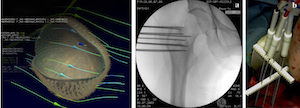Membrane permeabilization by pulsed electric fields (electroporation) is detected most precisely by monitoring changes in membrane conductance. For this purpose, several electrophysiological techniques are available. The whole cell configuration of the patch clamp technique offers the unique opportunity to drive the membrane potential for a few ms to values far outside the „usual“ physiological range in a controlled way, and to monitor the associated trans-membrane currents. This type of experiment was performed on culture cells of both plant and mammalian origin (tobacco "bright yellow-2" (=BY-2) and DC-3F cells, respectively), with very similar results. A technical pitfall potentially comes with the fact that the voltage imposed between the fine-tipped glass electrode, that is in contact with the cell interior, and the external reference electrode only partly drops at the membrane. This could be avoided with a correction routine that was experimentally verified by monitoring the membrane potential with the voltage-sensitive dye ANNINE-6. By plotting the recorded whole cell current against the actual voltage drop across the membrane, current-voltage curves were obtained that revealed a dramatic increase in membrane conductance when the membrane was polarized beyond certain threshold potentials of about -250 and +200 mV, respectively, (varying slightly with cell type and experimental conditions), whereas in the intermediate voltage range the membrane conductance remained very low. The conductance increase was reversible - at least to a large extent - within about 100 ms after the pulse. A more detailed quantitative analysis revealed that the data could be described in terms of a Boltzmann distribution for a two-state model (non-porated and porated state). Interestingly, electric field- induced membrane pores turned out to be highly cation selective. For BY-2 cells, the following selectivity sequence was obtained: Ca2+>Li+>Rb+~K+~Na+>TEA+~TBA+>Cl-. For DC-3F cells, a long-term or ‘persistent' permeabilization covering the whole voltage range was demonstrated in addition to the ‘transient poration' described above. The persistent one prevailed after the pulse for at least 40 min, the post-pulse time span tested experimentally. With mildly de- or hyperpolarizing pulses just above threshold potentials, the two processes could be separated, since persistent (but not transient) permeabilization required repetitive pulse exposure. In fact, a pronounced memory effect was associated with the persistent one, but it could also be elicited by single de-/hyperpolarizing pulses of very high field strength.
Precise monitoring of membrane properties during and after pulse exposure paves the way to develop new methods for a selective poration of certain cell types (e.g. cancer cells) in a complex environment, e.g. by a manipulation of poration threshold potentials in a cell-specific way. This will open up new opportunities, particularly in electrochemotherapy. Moreover, patch clamp data provide an experimental basis for a more refined modeling of electric field effects on membranes.
Wegner L.H., B. Flickinger, C. Eing, T. Berghöfer, P. Hohenberger, W. Frey, P. Nick. 2011. BBA - Biomembr. 1808:1728–1736.
Wegner L.H., S. Schönwälder. 2012. Proceedings of the EAPPC/BEAMS meeting 2012 Wegner L.H. 2013. BBA-Biomembr. 1828:1973–1981.
Wegner L.H., W. Frey, S. Schönwälder. 2013. Bioelectrochem. 92:42–46.
Wegner L.H. 2014. Bioelectrochem, doi:10.1016/j.bioelechem.2014.08.005, in the press Wegner L.H., W. Frey, A. Silve. 2014. Biophys. J., under revision

 PDF version
PDF version
